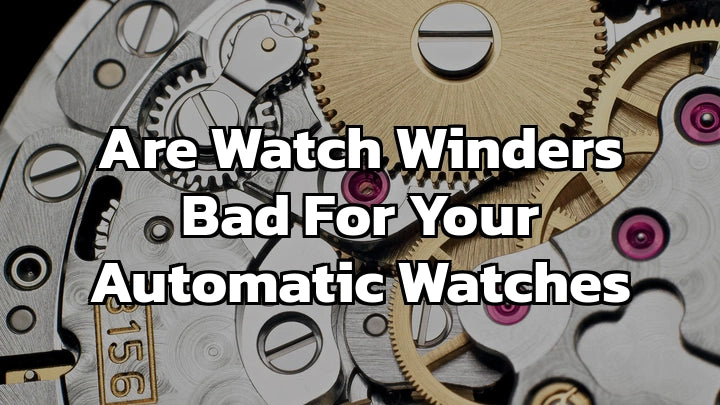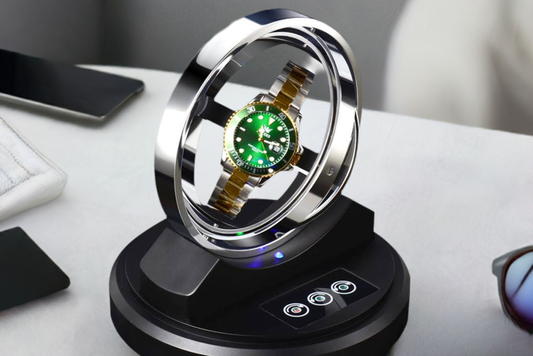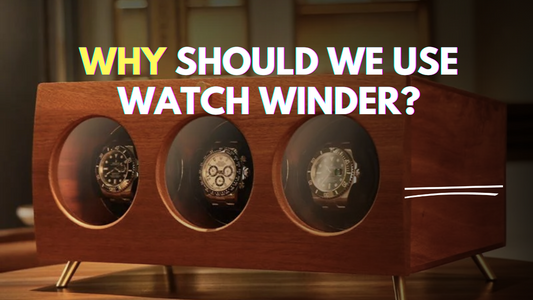Are watch winders a necessity or a luxury? Understanding the impact on automatic watches is crucial for making an informed decision. In this comprehensive guide, we'll explore the world of watch winders, debunking myths and providing valuable insights to help you determine whether a watch winder is right for your collection.
Do Watch Winders Damage Watches?
When it comes to the safety of using watch winders, one of the primary concerns is whether these devices can cause damage to the watches themselves. The short answer is that, if used properly, watch winders are generally safe for your timepieces. However, there are certain factors to consider to ensure that your watch remains unharmed.
One potential issue is the risk of over-winding, which can put excessive strain on the watch's gears and springs. This can lead to premature wear and tear or even breakage. To mitigate this risk, it is essential to choose a high-quality watch winder that is designed specifically for your watch's make and model. Look for winders with features such as automatic shut-off, adjustable torque settings, and gentle rotation to minimize the risk of over-winding.
Another consideration is the type of watch winder you use. There are two primary types: rotary and oscillating. Rotary winders rotate the watch in a circular motion, while oscillating winders move the watch back and forth in a more gentle, pendulum-like motion. Oscillating winders are generally considered safer, as they mimic the natural motion of the wearer's arm, reducing the risk of excessive strain on the watch's components.
In terms of actual damage, a study by WatchTime found that only 1.4% of watch owners reported damage to their timepieces due to watch winder use. This suggests that, when used correctly, watch winders are relatively safe. However, it is crucial to follow the manufacturer's instructions and take necessary precautions to ensure the safety of your watch.
Credit: YouTube Channel - The Urban Gentry
Magnetism Concerns: Fact or Fiction?
Another common concern surrounding watch winders is the potential impact of magnetism on the watch's accuracy and functionality. The fear is that the magnetic fields generated by the winder's motor can magnetize the watch's components, leading to inaccurate timekeeping or even complete malfunction.
However, most modern watch winders are designed with magnetism in mind. Many winders feature shielding or other technologies to minimize the risk of magnetization. Additionally, most watches are built with anti-magnetic materials and designs to protect against external magnetic fields.
In reality, the risk of magnetization is relatively low. A study by the Swiss watchmaking federation, FH, found that only 0.5% of watches are susceptible to magnetization, and even then, the effects are usually temporary and reversible. Furthermore, many watch manufacturers, such as Omega and Rolex, have developed watches with high levels of magnetic resistance.
To put your mind at ease, look for watch winders that are specifically designed to minimize magnetism, such as those with copper or mu-metal shielding. These materials are highly effective at blocking magnetic fields, ensuring that your watch remains safe and accurate.
Credit: YouTube Channel - He Spoke Style
Overwinding: Myth-Busting the Common Fear
One of the most pervasive myths surrounding watch winders is the risk of overwinding. The fear is that the winder will continue to wind the watch indefinitely, causing damage to the gears and springs. However, this is largely a misconception.
Modern watch winders are designed with safety features to prevent overwinding. Many winders feature automatic shut-off, which stops the winding process once the watch is fully wound. Others have adjustable torque settings, allowing you to customize the winding process to your watch's specific needs.
In reality, overwinding is relatively rare and usually occurs due to user error or improper winder configuration. A study by Watch Winder Reviews found that only 2.5% of watch winder users reported overwinding issues, and in most cases, these issues were resolved by adjusting the winder's settings or consulting the manufacturer's instructions.
To avoid overwinding, it is essential to follow the manufacturer's guidelines and adjust the winder's settings according to your watch's specific requirements. Additionally, consider investing in a high-quality watch winder with advanced safety features, such as the Orbita Sparta 1, which features automatic shut-off and adjustable torque settings, priced at around $400.
By understanding the facts behind watch winder safety, you can confidently use these devices to keep your timepieces accurate and well-maintained.
The Mechanics Behind Watch Winder Usage
Minimum TPD (Turns Per Day) Requirement
When it comes to watch winders, one crucial aspect to consider is the minimum TPD requirement. This refers to the number of times the watch winder needs to rotate per day to ensure the watch remains accurately wound and functional. The ideal TPD varies depending on the specific watch model and its mechanical properties.
For most automatic watches, a TPD of 600 to 800 is sufficient to keep the watch wound and running accurately. However, some watches may require more or less, depending on their power reserve and movement. For instance, watches with a higher power reserve might need fewer turns, while those with lower power reserves might require more frequent winding.
Customizing Rotations: Finding the Sweet Spot
Customizing the rotations of a watch winder is essential to ensure the watch is wound correctly and to prevent over- or under-winding. Watch winders often come with adjustable settings that allow users to tailor the number of turns per day to their specific watch needs. This customization is critical, as different watches have distinct winding requirements.
For example, some watches may require a gentle, slow winding motion, while others might need a more rapid rotation. The ability to adjust the TPD and direction of rotation ensures that the watch winder is optimized for the specific watch being used. This customization can be achieved through various settings, such as selecting the direction of rotation (clockwise, counterclockwise, or bi-directional), adjusting the number of turns per day, and even setting specific time intervals for winding.
The Effect of Constant Motion on Watch Mechanics
The constant motion of a watch winder can have both positive and negative effects on watch mechanics. On the positive side, a watch winder helps maintain the watch's accuracy by keeping it wound and running consistently. This is particularly important for watches that are not worn daily, as they can wind down and lose accuracy if left stationary for extended periods.
However, constant motion can also lead to wear and tear on the watch's mechanical components. The continuous rotation can cause friction and stress on the gears, bearings, and other moving parts, potentially leading to premature wear or even damage. This is why it is essential to choose a high-quality watch winder that is designed to minimize these negative effects and ensure the watch remains in optimal condition.
In conclusion, understanding the mechanics behind watch winder usage is crucial for maintaining the accuracy and longevity of automatic watches. By adhering to the minimum TPD requirement, customizing rotations to suit the specific watch, and being mindful of the effects of constant motion, watch enthusiasts can ensure their timepieces remain in pristine condition.
Pros and Cons of Watch Winders
The topic of watch winders and their impact on timepieces has sparked a significant debate among watch enthusiasts and collectors. As we delve into the world of watch winders, it is crucial to weigh the pros and cons of using these devices to ensure the optimal maintenance and preservation of our cherished timepieces.
Pros: Maintaining Accuracy and Preserving Watch Life
One of the primary benefits of using a watch winder is its ability to maintain the accuracy of automatic watches. Automatic watches, also known as self-winding watches, rely on the wearer's movements to wind the mainspring, which powers the watch's mechanism. However, when not worn regularly, these watches can lose their accuracy due to the depletion of the mainspring's power reserve. A watch winder solves this issue by mimicking the wearer's movements, ensuring that the watch remains wound and accurate.
Another significant advantage of watch winders is their role in preserving the life of the watch. Automatic watches contain intricate mechanical components that can be damaged if the watch is not wound regularly. A watch winder helps to prevent this damage by keeping the watch wound, thereby reducing the risk of mechanical failure. This is particularly important for high-end watches, where repairs can be costly and time-consuming.
Cons: Potential for Excess Wear and Tear
While watch winders offer several benefits, they also have some drawbacks. One of the primary concerns is the potential for excess wear and tear on the watch's mechanical components. If the watch winder is not properly calibrated or if it is used excessively, it can cause unnecessary wear on the watch's gears and bearings. This can lead to premature wear and tear, reducing the watch's lifespan.
Another issue with watch winders is their potential to cause over-winding. If the watch winder is not designed to detect the watch's power reserve, it can continue to wind the watch beyond its capacity, leading to damage to the mainspring or other mechanical components. This highlights the importance of choosing a high-quality watch winder that is designed to work in harmony with the watch.
Long-term Storage Considerations
When it comes to long-term storage, watch winders can play a crucial role in preserving the watch's condition. Automatic watches that are not wound regularly can suffer from mechanical damage, corrosion, and other issues that can affect their accuracy and overall condition. A watch winder can help to maintain the watch's condition by keeping it wound and running, even when it is not being worn.
However, it is essential to note that not all watch winders are suitable for long-term storage. Some watch winders are designed for short-term use and may not provide the necessary protection and maintenance for extended periods. When choosing a watch winder for long-term storage, it is crucial to select a high-quality device that is specifically designed for this purpose.
In conclusion, the use of watch winders can have both positive and negative effects on automatic watches. While they offer benefits such as maintaining accuracy and preserving watch life, they also pose risks such as excess wear and tear and over-winding. By understanding these pros and cons and choosing a high-quality watch winder, watch enthusiasts and collectors can ensure the optimal maintenance and preservation of their cherished timepieces.
Watch Winder Selection Criteria
When selecting a watch winder, several factors must be considered to ensure that the chosen device meets the needs of the watch and provides the best possible performance. The two primary considerations are the quality of the winder and its cost.
Quality vs. Cost: Why Expensive Watch Winders May Be Worth It
The quality of a watch winder is crucial in maintaining the accuracy and longevity of an automatic watch. High-quality watch winders are designed to mimic the natural movements of the wearer, ensuring that the watch remains wound and accurate. These winders often feature advanced programming, precise rotation patterns, and durable build quality. While they may be more expensive, investing in a high-quality watch winder can be worthwhile in the long run as it protects the watch from potential damage and ensures optimal performance.
Features to Look for: Programmability, Rotation Patterns, and Build Quality
Several key features should be considered when selecting a watch winder:
1. Programmability
Programmability is a vital feature in a watch winder as it allows the user to customize the winding pattern to suit the specific needs of the watch. This feature ensures that the watch is wound correctly and prevents over-winding, which can cause damage. Programmable watch winders often include settings for different types of watches and can be adjusted to accommodate various winding requirements.
2. Rotation Patterns
The rotation pattern of a watch winder is critical in simulating the natural movements of the wearer. A good watch winder should be able to rotate the watch in different directions and at varying speeds to ensure that the watch remains wound. Some advanced watch winders may include multiple rotation patterns, such as clockwise, counterclockwise, and bi-directional rotation.
3. Build Quality
The build quality of a watch winder is essential in ensuring its durability and longevity. A high-quality watch winder should be constructed from durable materials, such as wood or metal, and should have a sturdy design that can support the weight of the watch. The build quality also affects the overall aesthetic of the winder, making it a crucial consideration for those who value the visual appeal of their accessories.
By considering these features, individuals can select a watch winder that meets the specific needs of their automatic watch, ensuring that it remains accurate and in good condition.
Manual Winding and Watch Winder Alternatives
The world of watch winders and their alternatives. For watch enthusiasts, the debate surrounding the use of watch winders and their potential drawbacks is a significant one. Today, we're going to delve into the realm of manual winding, explore the pros and cons of watch winders, and provide some valuable tips for storing automatic watches without the need for a winder.
Manual Winding vs. Watch Winders
Manual winding, as the name suggests, involves manually winding a watch to keep it powered and running. This process typically involves turning the watch's crown to wind the mainspring, which in turn powers the watch's mechanisms. Manual winding is often seen as a more traditional and intimate way of keeping a watch running, as it requires a direct interaction between the wearer and the timepiece.
On the other hand, watch winders are mechanical devices designed to automatically wind a watch, mimicking the natural motion of the wearer's arm. These devices are particularly useful for automatic watches, which rely on the wearer's movements to wind the mainspring. Watch winders come in various forms, ranging from simple and affordable models to more sophisticated and expensive designs.
One of the primary concerns surrounding watch winders is their potential to cause wear and tear on the watch's mechanisms. Some argue that the continuous motion of the winder can put additional stress on the watch's gears and springs, leading to premature wear. Additionally, watch winders can be noisy and may not accurately replicate the natural motion of the wearer's arm, which can affect the watch's accuracy.
In contrast, manual winding eliminates the need for a mechanical device and allows the wearer to have complete control over the winding process. This approach can help reduce wear and tear on the watch's mechanisms and ensures that the watch is wound precisely to the wearer's preferences.
Storing Automatic Watches Without a Winder: Tips and Tricks
For those who prefer not to use a watch winder or do not have access to one, storing automatic watches requires some careful consideration. Here are some tips and tricks to help keep your automatic watches running smoothly:
- Store the watch in a cool, dry place: Avoid storing your watch in areas with high humidity or extreme temperatures, as this can affect the watch's mechanisms and accuracy.
- Keep the watch away from direct sunlight: Direct sunlight can cause the watch's components to expand and contract, leading to potential damage.
- Use a watch box or case: Store your watch in a high-quality watch box or case to protect it from dust, scratches, and other forms of damage.
- Wind the watch regularly: If you're not wearing the watch regularly, make sure to wind it every 7-10 days to keep the mainspring powered.
- Consider a watch winder alternative: If you're concerned about the potential drawbacks of watch winders, consider using a watch winder alternative, such as a manual winding device or a watch storage box with a built-in winding mechanism.
By following these tips and considering the pros and cons of watch winders, you can ensure that your automatic watches remain accurate, reliable, and in excellent condition.
In conclusion, the debate surrounding watch winders highlights the importance of understanding the needs and limitations of automatic watches. By weighing the benefits of manual winding against the convenience of watch winders, watch enthusiasts can make informed decisions about how to best care for their timepieces.
Debunking Common Misconceptions
I'd be delighted to delve into the world of watch winders and debunk some common misconceptions for you.
Will a watch winder harm a fully wound watch?
One of the most prevalent misconceptions about watch winders is that they can harm a fully wound watch. However, this is far from the truth. A well-designed watch winder is programmed to detect when a watch is fully wound and will automatically stop winding to prevent over-winding. This feature is crucial, as over-winding can indeed cause damage to the watch's mechanisms.
In fact, many modern watch winders come equipped with advanced features such as automatic watch detection, which can sense the watch's power reserve and adjust the winding cycle accordingly. For instance, the Orbita Sparta Series 1 Watch Winder, priced around $295, features a built-in microprocessor that monitors the watch's winding cycle and prevents over-winding. Similarly, the Wolf 27002 Watch Winder, priced around $399, boasts a patented technology that ensures the watch is wound to the optimal level, preventing damage from over-winding.
It's essential to note that not all watch winders are created equal, and some lower-end models might not have these advanced features. Therefore, it's crucial to invest in a high-quality watch winder from a reputable manufacturer to ensure the safety and well-being of your timepiece.
Running a watch 24/7: benefits and drawbacks
Another common misconception is that running a watch 24/7 is detrimental to its longevity. While it's true that constant motion can cause wear and tear on the watch's mechanisms, a well-maintained watch winder can actually help prolong the life of your timepiece.
Running a watch 24/7 can have several benefits, including:
- Improved accuracy: Mechanical watches are designed to run continuously, and a watch winder ensures that the watch remains accurate by maintaining a consistent power reserve.
- Reduced wear and tear: By keeping the watch's gears and mechanisms in motion, a watch winder can reduce the wear and tear caused by the watch's natural oscillations when it's not being worn.
- Prevention of lubricant breakdown: When a watch is left idle for extended periods, the lubric




